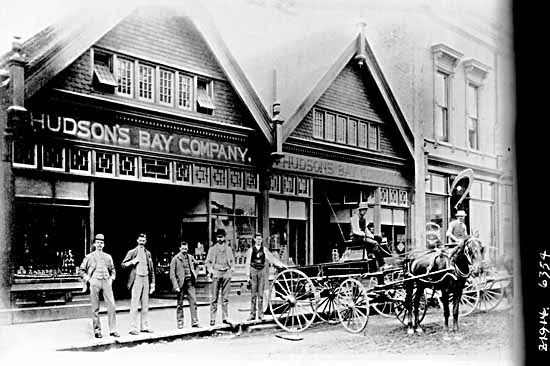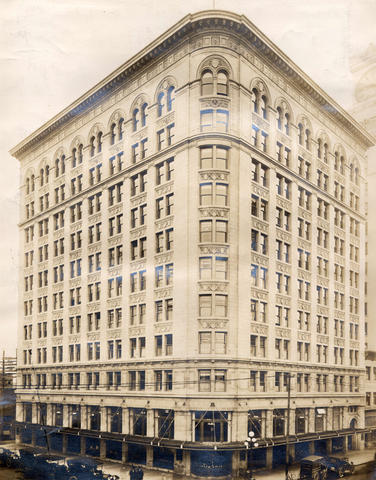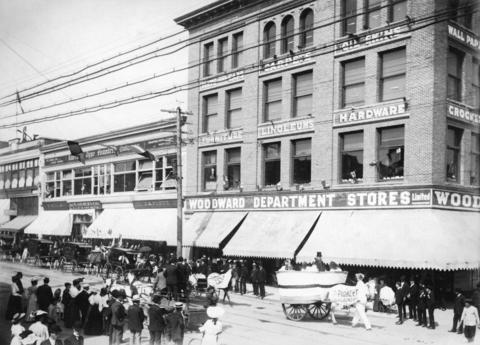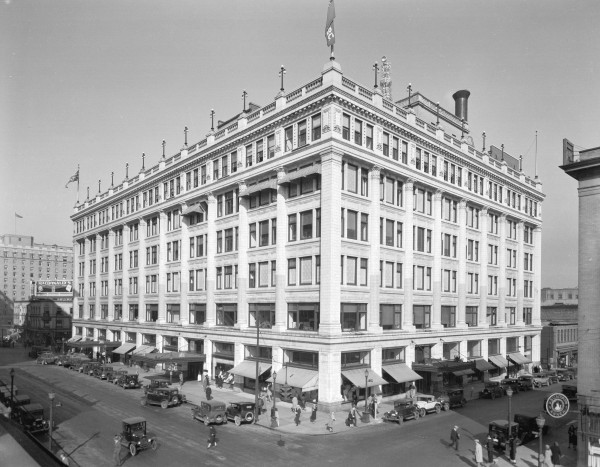Vancouver’s historic retailers have helped shape the appearance of our city. More than just places to purchase goods, some of the city’s most notable buildings were built by and for retailers. Conversely the loss of these significant buildings has also resulted in some big changes.

As Canada’s pioneering retailer, The Hudson’s Bay Company was the first to set up a new shop after the Great Fire of 1886. Originally located in a log building on Cordova Street, Hudson’s Bay would eventually build at what would become one of Vancouver’s most known and busiest intersections. The familiar Granville and Georgia location officially opened in 1926, after more than 10 years in the making. During the glamorous early days of department stores, the neo-classical flagship store boasted six floors of creamy terra cotta stone with Corinthian style columns. The recently installed canopies over the major street entrances are also styled after the original awnings which gave the building a grand feeling. The original Hotel Vancouver was across the street and Quebec jewelers Birks moved their operation from Hastings Street to a distinctive mid-rise tower on the opposite corner where they remained until 1975.

After almost 50 years gracing the corner opposite the Hudson’s Bay building, the well-loved terra cotta Birks building was demolished to huge public outcry. The elegant façade with its curved corner of windows and iconic clock was replaced by a low rise complex and tower. Even before the building demolition was complete, its demise inspired the establishment of the City’s Heritage Register. This catalogue of some of Vancouver’s buildings of particular historic or architectural value, was compiled in the hopes of preventing such sad losses in the future. In December 1974, The neighbouring Hudson’s Bay building was among the first additions to the Register along with the Credit Foncier Building, Hycroft Manor, and the Orpheum Theatre (to name a few). The 1906-08 Bank of Commerce, which became the new home for companion maids at the corner of West Hastings and Granville was also an early addition to the Register.

Other retailers have also influenced Vancouver’s architectural landscape. Spencer’s Department Store gave Vancouver an Art Deco style department store at the corner of Hastings and Seymour in 1907, before being bought out by Eaton’s in 1948, and eventually becoming the home of the SFU Downtown Campus in 1989. The story of Woodward’s decline also had an impact on our city and has often been tied in with Vancouver’s Downtown East Side. When Woodward’s closed the neighbourhood economy felt the change. The debate over the re-use of the Woodward’s site, as well as the iconic “W” sign would be another chapter in Vancouver’s history.
Recently the stately Hudson’s Bay flagship store received a significant facelift. The recipient of a City of Vancouver Heritage Award, the restoration heralds back to the glamour era of the large department store, making it once again a positive presence on one of Vancouver’s busiest corridors. In cases such as the Hudson’s Bay building, remarkable buildings can serve as a visual reminder of our history, as well as an attractive addition to our cityscape. In others their loss is an equally important memory of how our city has changed.
Want to learn more about the Hudson’s Bay renovation? Hear from Sarah Bjornson of Design Dialog, the architectural firm behind the re-imagining of the Hudson’s Bay store Wednesday September 25th at 12pm. VHF will be hosting the first Brown Bag Lunch and Learn of the year at BCIT’s downtown campus, Room 870. Tickets are $12, at the door or online.




